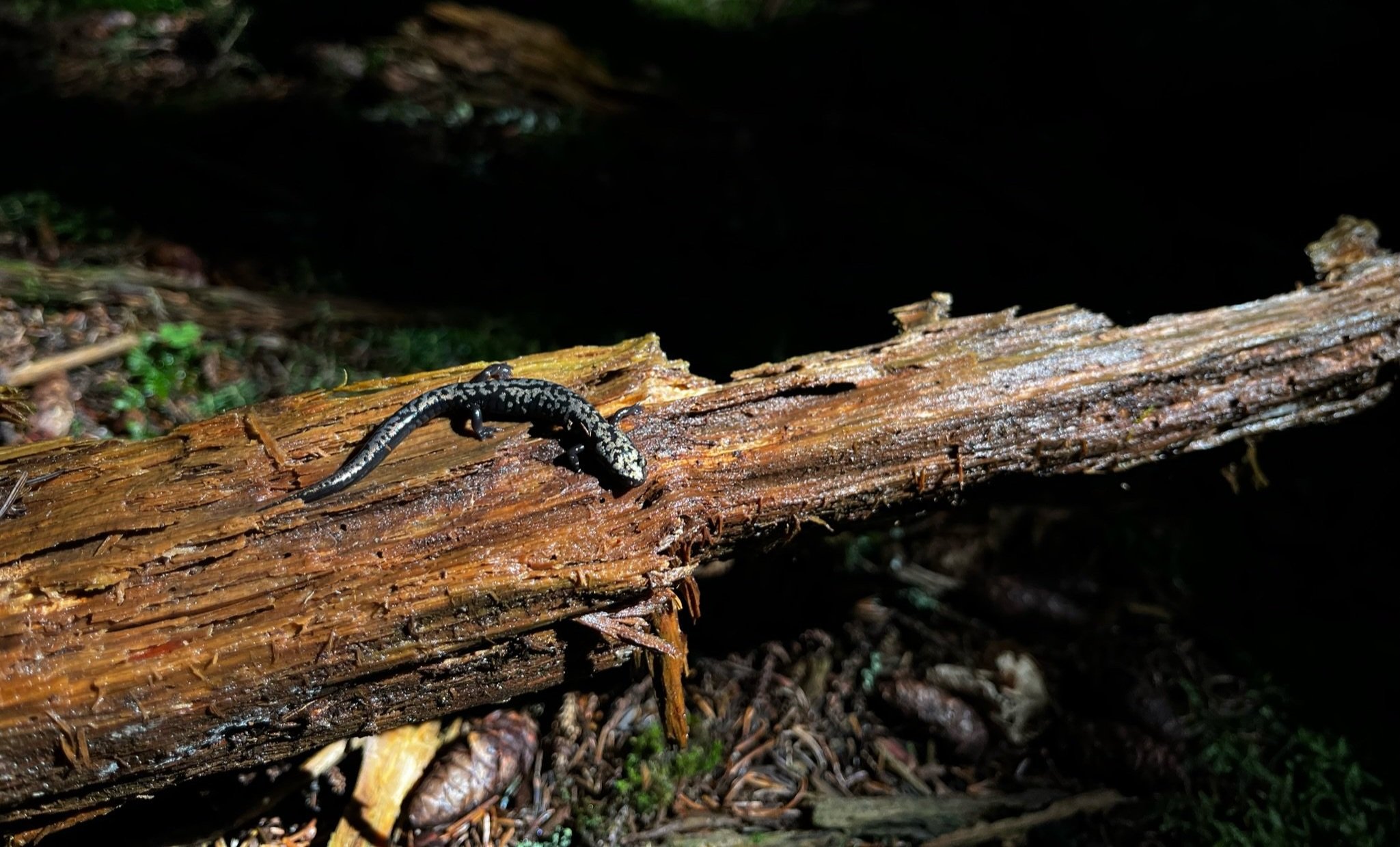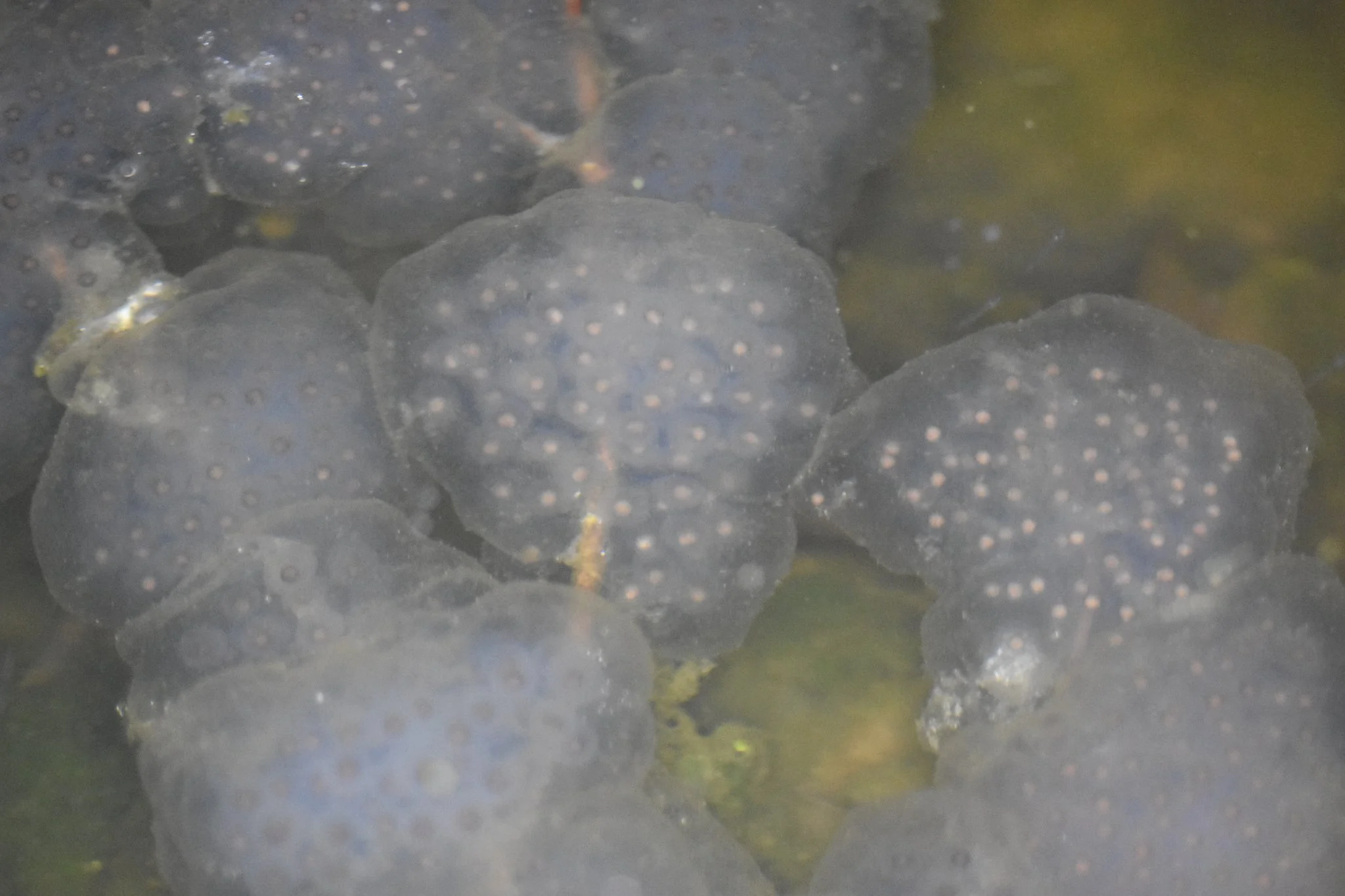As February draws to a close, the first warm spring rains nurture a tiny, threatened ecosystem nestled in the forest floor: vernal pools! Last week, our intrepid crew of BRDC naturalists had a chance to visit these ecosystems and celebrate on Ali Reilly’s last day as program coordinator at the Blue Ridge Discovery Center.
An adult Spotted Salamander (Ambystoma maculatum)
Vernal pools are seasonal wetlands that fill up in late February, making a home for amphibians that take amphibiousness to the extreme. Spotted Salamanders (Ambystoma maculatum) are migratory salamanders. In the summer, they disappear from the human world by burrowing up to six feet underground in wet burrows. The adults, around eight inches long, hunt earthworms, insects, and even small vertebrates hidden beneath the mud. But when the February rains reach temperatures of 50-60°F, these salamanders emerge from underground and start to move. Every year, they wander to the places they hatched in vernal pools, sometimes journeying miles. The males migrate first, and leave behind nutrient packets called spermatophores that also fertilize the eggs of females. Females arrive later, and lay clusters of around one hundred eggs on waterlogged branches.
Spotted salamander eggs are no ordinary eggs. Some clusters of eggs are milky-white, others are completely transparent aside from black dots (the developing salamander embryos), but all of the eggs share an amazing cohabitant. These eggs work in a symbiotic relationship with the Salamander Algae (Oophila amblystomatis). Salamander algae is mildly toxic to most aquatic wildlife, and produces sugars with photosynthesis. Protected in the gelatinous membrane of salamander eggs, the algae helps the eggs develop safely and quickly. Some of these algal cells may stick with the salamander for life, in pores on their skin even deep underground as adults. In their own unique way, spotted salamanders rank among the world’s few photosynthetic animals!
Spotted Salamander eggs, laid secretively on a rainy night in early March.
When the eggs hatch, tiny, four-legged tadpoles emerge; the salamander larvae. These salamanders are greenish-brown, have feathery external gills, and a translucent, paddle-shaped tail; bearing no resemblance to the large, yellow-spotted black adults. They are helpless, and almost any other carnivore in ephemeral wetlands can eat them with ease. It can take years for the larvae to metamorphose in permanent wetlands, and some never do. Vernal pools will dry in a few months. Normally, Southwest Virginia spotted salamanders require about four to five months (February-June) to reach a terrestrial stage. After crawling onto land and changing colors, the salamanders may require a few additional years before they grow large enough to return to the breeding grounds.
But they have to be lucky. Another mole salamander, the Marbled Salamander (Ambystoma opacum), lays eggs in November. Mothers guard the eggs on land, until February rains fill up the ponds. The mother leaves when the ponds are flooded, and her eggs hatch almost as soon as they are submerged. Marbled salamander larvae mature as spotted salamanders develop in the eggs, growing just large enough to hunt the spotted salamander larvae when they hatch. As adults, marbled salamanders are beautiful animals with black-and-white stripes. Males have solid white bands, while females have frosted gray bands. No two marbled salamanders, or spotted salamanders, have the same pattern, and individuals can easily be recognized from each other (especially those with unusual patterns). Mole salamanders can live for several years, and possibly for decades in ideal habitats.
A Marbled Salamander (Ambystoma opacum), leaving a vernal pool in late February.
Life is hard for these salamanders, but there is hope. On warm, rainy nights, you can help them! Many migratory salamanders are forced to cross roads at night, from backroads to highways, to travel from summer burrows to the winter breeding grounds in vernal pools. By carefully moving a salamander across the road in the direction it is traveling, you might save the next generation of salamanders. But remember, always make sure to prioritize your own safety when rescuing amphibians, and never attempt to save salamanders in dangerous conditions.











